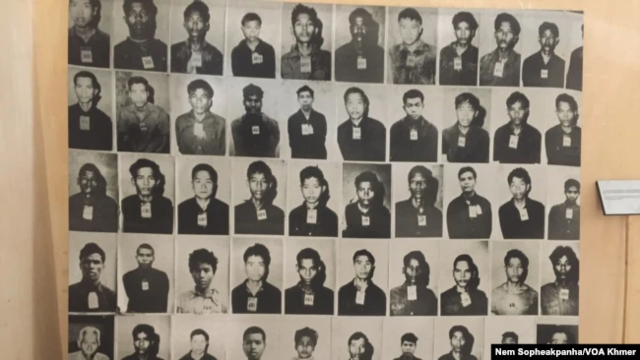


[Want even more content from FPM? Sign up for FPM+ to unlock exclusive series, virtual town-halls with our authors, and more—now for just $3.99/month. Click here to sign up.]
Last month, Megha Vemuri, president of the Massachusetts Institute of Technology class of 2025, denounced the “genocidal Israeli military” and contended that the MIT community “would never tolerate a genocide.” Such proclamations, widely repeated on Ivy League campuses, invite a look at the actual genocide going on 50 years ago.
In April, 1975, troops of the communist Khmer Rouge occupied Cambodia’s capital of Phom Penh. One of the last correspondents to leave was David Aikman of Time magazine, author of “Cambodia: An Experiment in Genocide.” As Aikman recalled:
After a few hours, the black-uniformed troops began firing into the air. It was a signal for Phnom Penh’s entire population, swollen by refugees to some three million, to abandon the city. Young and old, the well and the sick, businessmen and beggars, were all ordered at gunpoint onto the streets and highways leading into the countryside.
Among the first pitiful sights on the road, witnessed by several Westerners, were patients from Pnomh Penh’s grossly overcrowded hospitals, perhaps 20,000 people all told. Even the dying, the maimed and the pregnant were herded out stumbling into the streets. Several pathetic cases were pushed along the road in their beds by relatives, the intravenous bottles still attached to the bedframes In some hospitals, foreign doctors were ordered to abandon their patients in mid-operation. It took two days before the Bruegel-like multitude was fully under way, shuffling, limping and crawling to a designated appointment with revolution.
With almost no preparations for so enormous an exodus —how could there have been with a war on?—thousands died along the route, the wounded from loss of blood, the weak from exhaustion, and others by execution, usually because they had not been quick enough to obey a Khmer Rouge order. Phnom Penh was not alone: the entire urban population of Cambodia, some four million people, set out on a similar grotesque pilgrimage. It was one of the greatest transfers of human beings in modern history.
The slaughter was soon to follow. The Khmer Rouge executed victims by blows to the head with hoes, clubs and other blunt instruments. The Communist soldiers killed infants and children by smashing their heads against trees. They cut victims’ throats with knives, bayonets and scythes. Some were poisoned or suffocated with plastic bags.
The Khmer Rouge also maintained 189 interrogation centers, including S-21 in a former school now called Tuol Sleng. The Communists tortured prisoners with electric shocks and beat them into forced confessions. Of the 14,000-17,000 prisoners held there, only 12 survived.
The Khmer Rouge buried victims in mass graves that became known as “killing fields.” Out of a population of seven million the Stalinist Khmer Rouge killed some two million, approximately one-fourth of the population. On a proportional basis, it was the worst mass murder of the century.
News of the genocide began to emerge in June, 1976, and in 1977 John Barron and Anthony Paul published Murder of a Gentle Land: The Untold Story of Communist Genocide in Cambodia, which the Khmer Rouge rebranded “Democratic Kampuchea.”
Sen. George McGovern, the South Dakota Democrat known for opposition to the American war effort in Vietnam, called it “a clear case of genocide” demanding a military intervention. Rep. Stephen Solarz, New York Democrat, said indifference to the situation was “almost as appalling as what is going on there.”
President Jimmy Carter, Georgia Democrat, called Cambodia the worst violator of human rights in the world. The United Nations, as David Aikman noted, “ever quick to adopt a resolution condemning Israel or South Africa, acted with its customary tortoise-like caution when dealing with a Third World horror: it wrote a letter to Phnom Penh asking for an explanation of charges against the regime.”
At the time, the UN was headed by Kurt Waldheim, yet to be outed as a Nazi war criminal in the pocket of the Soviet Union. Noam Chomsky, the left’s most high-profile public intellectual, took it to another level.
“What filters through to the American public,” Chomsky wrote, “is a seriously distorted version of the evidence available, emphasizing alleged Khmer Rouge atrocities and downplaying or ignoring the crucial U.S. role, direct and indirect, in the torment that Cambodia has suffered.” (emphasis added) Chomsky’s views gained traction in Hollywood.
The Killing Fields, from 1984, shows American planes dropping bombs but viewers do not see the Khmer Rouge killing anyone by any of the means they found necessary. Interrogation center S-21 is now the Tuol Sleng Genocide Museum. The United States Holocaust Memorial Museum has included an exhibit on Cambodia, where “at least a quarter of the country’s population” perished under the Khmer Rouge regime. That is what actual genocide looks like.
The term also applies to the Nazis’ industrialized attempt to eliminate Jews from the earth.
On October 7, 2023, Hamas launched the worst attack on Jews since the Holocaust. To paraphrase Rep. Solarz, who died in 2010, to use the term “genocide” in regard to Israel’s defensive response, is almost appalling as the 10/7 attack itself. In 2025 moving forward, it’s all about memory against forgetting.
